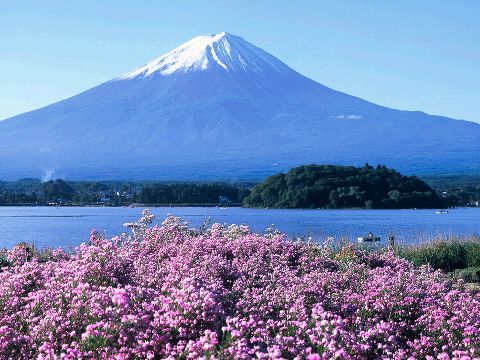
Mt.Fuji

Mt. Fuji, rising above the clouds, is the symbol of Japan and has provided a spiritual basis for the Japanese since ancient times. This 12,380 ft high, dormant volcano is world renowned for its symmetry and serenity. Located between Yamanashi and Shizuoka, Mt. Fuji is the main attraction of the Fuji-Hakone-Izu National Park. Snow-covered tranquility in winter, vitality and energy in summer--seasonal changes glorify this national treasure. From near or far, from plane or train, one cannot look at Mt. Fuji without marveling at its beauty.

Heavy volcanic activity, which started several hundred thousand years ago and ended in 1707, sculpted the present, gentle shape of this beautiful mountain. Accounts of climbing Mt. Fuji go back rather far as well, as records indicate. Early on, this sacred mountain was climbed by the pious, who endured several days of hardship in their quest. In 1892, Waston, the pioneer of mountain climbing in Japan, reached the top. Many climbers, regardless of age or gender, have since visited the summit in the climbing season of July and August. If you like mountain climbing and have not yet climbed Mt. Fuji, you should try it sometime.

Spring brings cherry blossoms to the foot of Mt. Fuji in mid-April, followed by the blossoming of vermillion azaleas, which announce the coming of summer greenery. July 1st is the traditional opening day for climbers because perilous snow remains above the fifth level, at 7,868 ft, until the end of June. The alpine rose and other alpine plants are in bloom and ready to be enjoyed by the first climbers of the season. Summer on Mt. Fuji is rather short, only lasting until late August, when the traditional Yoshida Fire Festival brings the climbing season of Mt. Fuji to a close.

The dramatic changes of Mt. Fuji’s climate are evident in the striking difference between the climate of the southern slope and that of the northern one. The temperature differs by about 68o F from top to base, resulting in an annual average temperature of 20o F. The atmospheric pressure at the summit is only 2/3 of that at the foot of the mountain. To get to Mt. Fuji from Tokyo, first take a train from Shinjuku to Kawaguchiko, then a bus from Kawaguchiko station along the Fuji-Subaru line to the fifth level. Total travel time is about 3 hours and 30 minutes. Mt. Fuji is relatively easy to climb for most people, but because of the high altitude, it is best to be well prepared. We suggest you wear comfortable shoes and bring extra layers of clothing for sudden climate changes. Also please take time to rest at steady intervals as you climb.